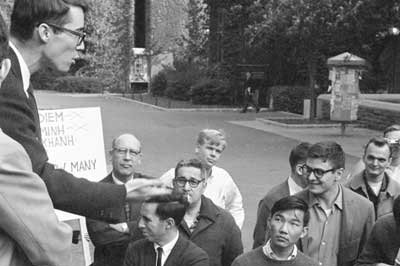Kiyoshi Kuromiya, a local AIDS activist who died in 2000, once regaled an interviewer with an amusing anecdote about his childhood in suburban Monrovia, Calif.
In 1954, when he was just 11 years old, Kuromiya was caught by the police engaging in harmless sexual play with a teenage boy, which led to an appearance before a stern judge at juvenile hall.
In court, Kuromiya recounted, the judge “told me that I was in danger of leading a lewd and immoral life.” Chuckling, he continued, “I spent two years trying to find a definition for the word lewd, but I couldn’t figure out how it was spelled, so I was in the dark as to what my future held for me.”
Actually, an eventful life was awaiting the precocious youth. Just 57 when he died from AIDS-related complications, Kuromiya had met and worked alongside notable figures, including civil-rights leader Dr. Martin Luther King Jr. and the visionary thinker R. Buckminster Fuller. He was also a nationally ranked Scrabble player and a yoga master.
Kuromiya’s most substantial achievement, however, was founding the Critical Path Project in 1989. Originally conceived as a newsletter, Critical Path was designed to empower PWAs by providing them with information enabling them to participate fully in their medical treatment. By the early 1990s, he had harnessed the power of the Internet and transformed the publication into an online clearinghouse for patients and researchers worldwide.
Yet despite these accomplishments, many people are unaware of Kuromiya’s accomplishments.
Che Gossett hopes to rectify that situation. The genderqueer activist and author is currently working on a biography of Kuromiya. In the midst of combing through archives — William Way LGBT Community Center houses more than 40 boxes of the activist’s papers — this fierce black femme also found time to direct a brief documentary on Kuromiya.
The video, which is a work in progress, will be screened at 7 p.m. June 9 at Wooden Shoe Books, 704 South St.
Gossett, whose preferred pronoun is they, first learned of Kuromiya in 2008, shortly after arriving in Philadelphia, where they came to pursue graduate studies. With their interest in social movements — particularly grassroots activism, queer history and transgender politics — Kuromiya proved to be an ideal subject.
A Japanese-American, Kuromiya was born during World War II at the Heart Mountain internment camp in Wyoming, an experience that affected him profoundly. Arriving in Philadelphia in 1961 to attend the University of Pennsylvania, he threw himself into the struggle for civil rights and protests against the war in Vietnam, experiences that informed his later work as an AIDS activist.
What triggered Gossett’s interest in making the documentary was locating the audio tape of a three-hour-long interview Kuromiya did with the Philadelphia Folklore Project in the late 1990s.
“I was working on a biography of Kiyoshi,” Gossett explained. “The biography came first. I had done a lot of research; then I got the audio. It’s powerful, different. It’s Kiyoshi reflecting on his life and the movements he was involved in and what he learned from them.”
Indeed, one of the documentary’s chief pleasures is hearing Kuromiya’s deep, expressive voice. His tone, alternately reflective and humorous, gives the impression that the pony-tailed figure is present and talking directly to viewers.
Kuromiya’s FBI file also proved to be a treasure trove of information. According to Gossett, the agency placed the young radical on its national security index because of his “anarchist tendencies,” monitoring him for roughly 12 years, from 1960 until 1972.
In addition to numerous photos of Kuromiya and transcripts of his speeches, the file also afforded Gossett insight into the broader history of radical Philadelphia.
“It’s copious, over 100 pages,” the filmmaker said of the file. “The material was collected as part of COINTELPRO, a domestic program that uses surveillance and sabotage to undermine the New Left and the Black Panther Party.”
As the documentary shows, Kuromiya had a knack for being in pivotal places at opportune moments. In 1965, he rushed to Alabama to support Dr. King’s voting-rights efforts, only to be clubbed so badly by sheriffs that he required 22 stitches. Accounts of the incident were covered in both the national press and his hometown newspaper.
Undeterred, Kuromiya joined Students for a Democratic Society and traveled to Washington, D.C., for the 1967 “March on the Pentagon,” a protest chronicled in Normal Mailer’s famous book, “The Armies of the Night.”
By the time Kuromiya cofounded the Gay Liberation Front in 1970, he had already accumulated a wealth of experience as a political activist, which he put to good use.
“We were gathering the experiences from one movement and using them for other movements,” he later recalled.
In its current version, Gossett’s documentary does not examine many aspects of Kuromiya’s life, but it still makes a persuasive case that the indefatigable organizer viewed the liberation struggles emerging in the 1960s as inextricably bound and as a radical challenge to the status quo.
Discussing the GLF, for example, Kuromiya said: “We would be the group that showed up at a welfare-rights demonstration and be 40 percent of the crowd. We were the people that would support the Latina mothers or the Concerned Powelton Residents or whatever organization it was. We were really community activists.”
Kuromiya worked his entire life to build that community; Gossett gives it new vigor with this provocative new documentary.
